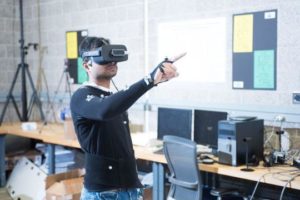Virtual Reality: OSU study shows how to reduce physical risk
 “There are no standards and guidelines for virtual and augmented reality interactions,” OSU’S College of Public Health and Human Sciences researcher Jay Kim said. “We wanted to evaluate the effects of the target distances, locations and sizes so we can better design these interfaces to reduce the risk for potential musculoskeletal injuries.”
“There are no standards and guidelines for virtual and augmented reality interactions,” OSU’S College of Public Health and Human Sciences researcher Jay Kim said. “We wanted to evaluate the effects of the target distances, locations and sizes so we can better design these interfaces to reduce the risk for potential musculoskeletal injuries.”
Virtual reality users wear a headset and engage in full-body, three-dimensional movements – unlike conventional computer users, where a desk or the arms of a chair offer some level of support for the hands and arms.
Researchers repeated the tests with the visuals placed at eye level, 15 degrees above eye level, 15 degrees below eye level and 30 degrees below eye level.
Regardless of the angle, extending the arm straight out causes shoulder discomfort in as little as three minutes, Kim said. With prolonged use, as VR often requires, this may lead to major health problems like gorilla arm syndrome and rotator cuff injuries.
The goal of the study was to establish a baseline of optimal object placement and angles, so VR developers going forward can design games and programs that minimize user discomfort.
“Based on this study, we recommend that objects that are being interacted with more often should be closer to the body,” Kim said. “And objects should be located at eye level, rather than up and down.”
The study was published in Applied Ergonomics with Northern Illinois University co-authors Sai Akhil Penumudi, Veera Aneesh Kuppam and Jaejin Hwang.
See the full story here: https://www.thechronicleonline.com/news/virtual-reality-osu-study-shows-how-to-reduce-physical-risk/article_7eb242e2-3722-11ea-aadc-076b4a3b112d.html
Pages
- About Philip Lelyveld
- Mark and Addie Lelyveld Biographies
- Presentations and articles
- Tufts Alumni Bio